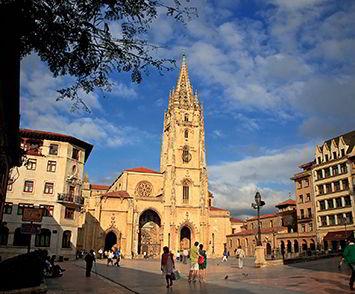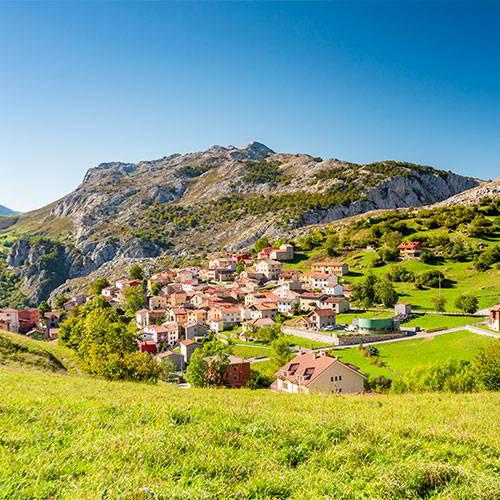The importance of 2018 as a year of ephemeris
Its best expression is a natural cave, the scene of history, where an image of the Virgin is venerated, which was crowned in the hearts of Asturian society a hundred years ago.
Precisely in 2018 the first centenary of the Canonical Coronation of the Virgin of Covadonga was celebrated, as well as the first centenary of the launch of the Picos de Europa National Park and the 1300th anniversary of the origin of the Kingdom of Asturias, and coinciding with this triple anniversary, a Marian Jubilee Year was celebrated, which allowed the thousands of pilgrims who came to Cuadonga/Covadonga to gain the Jubilee and plenary indulgence.
/documents/39908/68682/2291000.jpg/85a52807-ecec-82fb-b06a-5525e55c6d06?t=1679298469363

Virgin of Covadonga
/documents/39908/68682/2290707.jpg/0ce2a5dc-e7ee-6b6d-8037-55c31df29099?t=1679298456923

View of the Basilica of Covadonga
One hundred years of a coronation
In 1918 the Virgin of Covadonga was crowned in the Royal Site.
The link between Cuadonga/Covadonga and Marian devotion is intimate, for although it could be the Christianisation of an earlier pagan cult of the waters or natural divinities, certainly since medieval times the site has clearly been a place of devotion to the Virgin Mary.
A devotion that has its first legends in the time of Pelayo and Alfonso I, but which from the end of the 9th century is undoubtedly related to the triumph of war and the cult of the so-called "Virgen de las Batallas" (Virgin of Battles). This led to the establishment of a community at the service of the sanctuary and an initial flow of pilgrims who visited it with devotion, and the Spanish monarchy took it under its patronage as a material symbol of its dynastic origins.
However, although it was a place of great devotional and identity importance for the Asturian region - especially for the easternmost area - its great boost came in the 19th century with Bishop Sanz y Forés. Moved by the revitalisation of the nineteenth-century Marian cult, during his episcopate he sought to endow Covadonga-Cuadonga/Covadonga both with buildings and other material goods and with various graces that he requested from Rome, such as the patronage of the region, the existence of its own feast day and the indulgences and jubilees to which it was entitled. This will give new vitality to the sanctuary and the cult of the Santina, which will find its best expression in her canonical coronation one hundred years ago.
Little is known about the birth and development of Marian devotion to Covadonga in the early medieval centuries, although it is very likely that the tradition of the miraculous intervention of the Virgin in the Pelagian battle led to the first veneration of this "Virgin of Battles". In the 12th century, the first evidence of the existence of a place of worship in Covadonga appears, which will soon receive the support of the Castilian kings and, from Modern times, of the Hispanic Monarchy itself, interested in promoting its foundational landmark in this part of Asturias. This support will undoubtedly result in an extension of devotion and an increase in pilgrimages, vows and promises, which has been incessant throughout history.
On 8 September 1918, the Sanctuary experienced an exceptional event. On the occasion of the XII Centenary of the Battle of Covadonga, the image of the Blessed Virgin and Child was canonically crowned. This is a liturgical rite that marks the notion of the Virgin Mary as Queen of the Church. A grace that the bishop of Oviedo had requested from the Pope for the occasion, and which took shape that day in Covadonga in the presence of King Alfonso XIII and Queen Victoria Eugenia de Battemberg, as well as Cardinal Victoriano Guisasola Menéndez, several bishops and a multitude of faithful and devotees.
During the Civil War, the Sanctuary was closed, the elements of worship were removed and it was used as a hospital. At the request of Indalecio Prieto, the Provincial Committee of the Popular Front commissioned Faustino Goico-Aguirre, provincial delegate of Fine Arts, to collect the image of the Virgin of Covadonga, which had been jealously guarded by some nuns and nurses who worked in the hospital set up in the sanctuary, and transferred it to Gijón, to the Ateneo Obrero (Workers' Athenaeum). In September 1937 the image was transferred to the Spanish embassy in Paris, along with other works of art. At the end of March 1939, at the end of the war, the news of the presence of the Virgin in the embassy became known. The new national government and the bishopric of Oviedo organised its return to the Shrine, where it would arrive on 6 July 1939.
History of a Centenary
The centenary of 1918 and the canonical coronation of the Virgin were the ideal moment to compose a hymn that would serve as a musical identity mark for the sanctuary and Marian devotion, as well as a remembrance of the historical events of Cuadonga/Covadonga, with unquestionable value for Asturias and for the whole of Spain. It was an initiative started by Fermín Canella, rector of the University of Oviedo and chronicler of Asturias, for which a composition competition was held, and Sagastizábal's work was selected, with lyrics by Restituto del Valle. Thus, in September 1918, the "Bendita la Reina de nuestras montañas, que tiene por trono la cuna de España" (Blessed Queen of our mountains, whose throne is the cradle of Spain) was played for the first time in the sanctuary and has been heard so many times to this day.
/documents/39908/68682/2290775.jpg/0551fbad-dffc-67ad-0aff-998d87ef4a15?t=1679298461572

Holy Cave
A cave with a lot of history
This etymology clearly testifies to the importance of the Marian cult in this enclave. Some legends speak of a cave hermitage in the time of Pelayo or a foundation by Alfonso I, but the truth is that only one monastic community has been documented in Cuadonga/Covadonga since the beginning of the 12th century.
Whatever the case may be, this is a thousand-year-old devotion in a setting of exuberant nature where the imposing mountains, the lushness of the forest, the strength of the water and, in short, the grandeur of the landscape make up an infinitely beautiful ensemble suitable for spiritual worship.
/documents/39908/68682/2290791.jpg/e456d9b1-c67b-8ee0-15ea-ac3b6922bf25?t=1679298441848

Surrounding area of the Sanctuary of Covadonga
The Histories that have been handed down since the 9th century clearly show the precise location of a cave in the foothills of Mount Auseva where the Christians who fought in a victorious battle took refuge. The intercession of the Virgin turned this cave into a Marian temple that soon became a symbol of the victory of the faith, and its rugged and remote location contributed to its uniqueness. All of this was sanctioned by the Crown itself, as it soon became a sanctuary of royal patronage and a recipient of privileges.
Since then, the Holy Cave, guarding the image of the Virgin intercessor of the victory of Cuadonga/Covadonga and the remains of the first kings of Asturias, has been consolidated as the heart of a sanctuary that combines Marian faith, nature and historical tradition, under the care of a community settled here. It soon became a pilgrimage destination for pilgrims from all over Asturias and other territories.
The hanging temple, the "Miracle of Covadonga".
/documents/39908/68682/2291192.jpg/1e6c043e-0191-49c7-e18d-cc245c92019c?t=1679298424093

Panoramic view of the Holy Cave
The first recorded temple at Cuadonga/Covadonga was located in the cave itself, gaining space in the air. It was a small wooden structure - except for a stone chapel that housed the image - which was built into the cave and rested on a cantilevered beam that seemed to hang from the mountain. It was called the "Miracle of Covadonga", as it was thought to have been built by angels for the glory of the Virgin. It was reached by the Stairway of Promises, still in existence today, which ascended to the cave, parallel to the old collegiate church.
The fire of 1777
/documents/39908/68682/2290968.jpg/db5e6243-852a-6324-4ae6-044c83b81b42?t=1679298475494

Engraving of the cave before 1777
This complex constituted the Sanctuary of Covadonga that illustrious scholars visited and described to us, and it is the one that the Spanish Crown took under its direct protection decisively from Philip II onwards. However, on 17th October 1777, a fortuitous fire - possibly caused by the lamps in the chapel - reduced the temple to ashes, with the loss of jewellery, votive offerings, ornaments and the image of the Virgin herself. The wooden construction and its steep location made it impossible to fight the fire, and that day a heritage whose remains were pulled out of the river days later was completely lost.
Ventura Rodríguez's failed project
/documents/39908/68682/2291207.jpg/c405c325-280b-b21f-15f3-d375cb9693a3?t=1679298409576
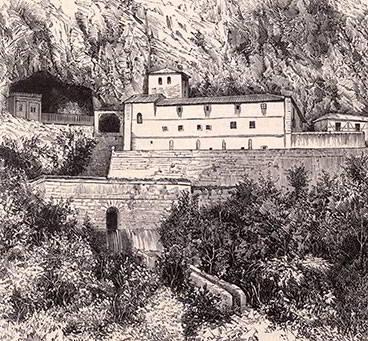
Xylography of the Collegiate Church in 1860
After the fire, the canons turned to the Crown for funds to rebuild the church. The House of Castile commissioned the prestigious architect Ventura Rodríguez, of the San Fernando Academy of Fine Arts, to design the new church. In 1780 he designed a majestic two-storey neoclassical basilica over the pond in front of the cave. The monarchy took centre stage, centring the temple on the mausoleum of Pelayo and keeping the Santina in the cave, visible behind a large window. Although an initial budget was disbursed, the opposition of the canons to the design meant that only the pond under the cave could be built and channelled, and in 1796 the work was finally halted.
A 19th century under the influence of Roberto Frassinelli
/documents/39908/68682/2290904.jpg/61a270ae-f057-9fc9-1c99-82abe4692521?t=1679298436970

Frassinelli's dressing room in 1906
The visit to the Sanctuary by the Dukes of Montpensier in 1857, and especially the visit the following year by Queen Isabella II, gave a boost to the work on Cuadonga/Covadonga. Nicolás Cástor de Caunedo presented Nicolás Cástor de Caunedo with a project for a historicist temple as a new monument to the Pelagian monarchy. But this project was not completed either, nor were other attempts by the Provincial Monuments Commission. It was not until the episcopate of Sanz y Forés and his commissioning of Roberto Frassinelli that the cave was remodelled in 1875: a carved wooden dressing room with a profuse decoration inspired by Asturian pre-Romanesque art, where the Virgin was placed, leaving the rest of the grotto diaphanous.
The Holy Cave today
/documents/39908/68682/2290839.jpg/ff20655c-0096-a1ca-055e-c14866aa9f14?t=1679298455404

Holy Cave
After the Civil War, the damage caused to the grotto led to the dismantling of the chapel and the construction of the surroundings that can be seen in the grotto today. The mission was entrusted to the architect Luis Menéndez Pidal, who sought to give prominence to the natural environment of the cave and its landscape together with the image itself, building a small chapel or sacristy following the patterns of the Asturian pre-Romanesque style and seeking a sober ornamentation that would turn the cave itself into a true natural temple.
/documents/39908/68682/2290984.jpg/9c7bec37-5ac3-ec17-c0c9-4bcd1814a548?t=1679298420853
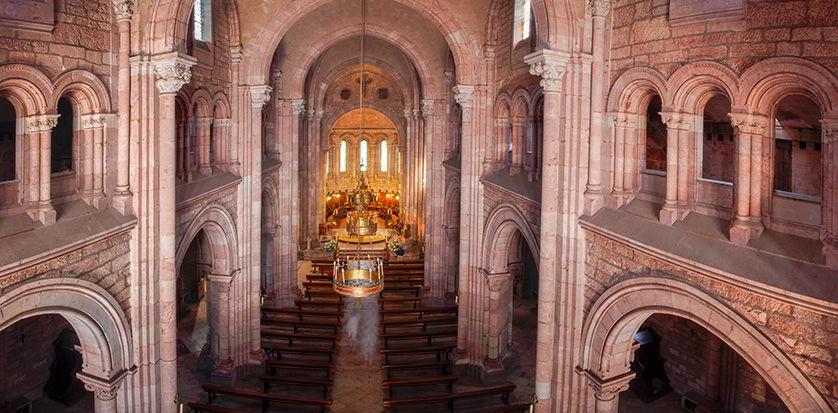
Interior of the Basilica of Covadonga
The Basilica of Covadonga
On the day the Camarín de la Cueva was consecrated in 1874, the bishop of Oviedo, Benito Sanz y Forés, announced to the faithful his intention to provide the Sanctuary with a monumental temple. Although it would take a couple of years before it could be built, it was decided to erect this "Cathedral of Covadonga" - as it was called for many years - on the Cueto hill, a small elevation in the centre of the valley and opposite Mount Auseva, which offers a spectacular view of the Holy Cave and its natural surroundings.
Frassinelli was once again chosen to design the building, continuing the medieval revival he had begun with the chapel, although on this occasion he chose the neo-Romanesque style. Frassinelli's project was not executed as conceived and the architect Federico Aparici y Soriano was ultimately responsible for the work. Thus, in 1877 the works began with the clearing of the Cueto hill, and King Alfonso XII was in charge of detonating the first of the boreholes.
Fifteen years after that hole, the dream of so many faithful and pilgrims, visitors and travellers of all ages took shape in the midst of the natural lushness that has always characterised this place in the Picos de Europa.
The Basilica of Covadonga has been one of the historical and spiritual icons of the Royal Site for more than a century, attracting thousands of travellers eager to discover all the secrets of a unique place in the world.
Although Frassinelli's first project, pushed by Monsignor Sanz y Forés, had four towers, the two that resulted in the final construction in no way detract from its monumentality. The Basilica of Santa María la Mayor de Covadonga stands in the middle of the green valley of the river that rises below the cave and stands out clearly because of the pink tone of the Peñalba limestone used. It is entirely built - both its almost unknown crypt and the exterior and interior of the temple - in a neo-Romanesque style where sobriety reigns. And so it was that in 1901 the basilica was consecrated by a new prelate from Oviedo, Ramón Martínez Vigil.
At the end of the 19th century, other buildings were erected next to the Basilica to solve some of the Sanctuary's deficiencies, such as the new collegiate church or some houses for the canons. But, thinking especially about the reception of the increasing number of pilgrims who were overflowing the old Mesón, the Hotel Pelayo was built for their accommodation, maintaining stylistic and chromatic unity with the rest of the complex. The Gran Hotel Pelayo opened its doors in 1909, and with more than one hundred years of history behind it, it forms part of the recent history of the Royal Site.
Barely a decade after the opening of the Gran Hotel Pelayo, the idea was to offer a second, more modest accommodation option, and so the Hostal Favila was designed and built, located on the same esplanade as the Basilica, very close to the entrance to the Cave. The old Hostal Favila - which opened in 1931 - took a lot of effort and effort to build, and almost a century later, it is now another of Covadonga's emblematic buildings. With the passing of time, what was conceived as accommodation became the Minor Seminary, and later the headquarters of the Museum of Covadonga and the Escolanía, a function it fulfils to this day.
A Ritual and Pilgrimage Space
Covadonga is a universal point of reference for spirituality
Cuadonga/Covadonga is much more than the Holy Cave and the Basilica. Of course, the Sanctuary complex is completed with other buildings such as the aforementioned Hotel Pelayo and Hostal Favila, as well as others. But, undoubtedly, Cuadonga/Covadonga is to a large extent the people who are there, those who live and attend to the sanctuary or the pilgrims and visitors who come there. They are the human landscape of Cuadonga/Covadonga, as rich and fundamental as the spiritual and natural landscape to be admired in the Royal Site and its surroundings.
History of a Collegiate Church
/documents/39908/68682/2290727.jpg/262f5a9f-dc4f-9ca9-12a9-dbdab3150107?t=1679298430509

Cloister of the Collegiate Church of San Fernando
The Collegiate Church of San Fernando is the oldest building in the Sanctuary, although it does not survive in its original form. At the foot of the grotto, at the level of the last flight of the Staircase of Promises, there was an early monastic building with a cloister that served as a residence for the abbot and the canons who, since at least the 12th century, had been in charge of worship in the hanging church. It was a very modest building whose antiquity is attested by the Romanesque tombs preserved in the cloister of the collegiate church itself.
With the passage of time, that first building deteriorated and became uninhabitable. It was royal patronage between the 16th and 17th centuries that provided the religious community with a new monastery. And so it was from this thrust that the building that is visible today in a space apparently reclaimed from the mountain was built: a two-storey rectangular structure around a courtyard and an inner cloister, with a tower at one end and the chapel on the side next to the cave.
After the Civil War, a twin building was erected next to the Collegiate Church, which was to become the Casa de Novenas, and in the space between them stands an ornamental fountain inspired by the time of Charles III.
Sacred music in Covadonga: The Escolania
/documents/39908/68682/2290889.jpg/395b95ab-00cf-35f7-e8f5-a5695b664286?t=1679298468577

Choir of Covadonga
Music has always been one of the hallmarks of worship at Cuadonga/Covadonga. Since the last century, music in the Royal Site has been personified in the Escolanía (Choir). It is a choir of white voices that contributes to the liturgy and the veneration of the Santina, giving the celebrations a particular solemnity.
The group of children between the ages of 8 and 18 who make up this choir live at the Sanctuary during the school year, as they combine their academic training with a great deal of musical and choral preparation under the direction of renowned musicians.
During these decades, many former choirboys have made music their professional activity - orchestra conductors, choirs, conservatory teachers and instrumentalists - and some of them as teachers of the following generations of the Escolania.
The presence of women's religious orders
/documents/39908/68682/2291032.jpg/d5035d52-7092-7ce3-b6c1-6006f1dc0549?t=1679298453094

Women's religious orders
Although their presence can often go unnoticed, the Sanctuary of Covadonga owes much of its existence to the nuns who form part of the permanent community around the Santina. There are currently two female communities living together in Covadonga. The most recent arrivals are the Daughters of St. Mary of the Heart of Jesus, a congregation that since the end of 2014 has been attending to the pilgrims who come to the Diocesan House of Spirituality located in front of the Collegiate Church of San Fernando. That year they took over from the Handmaids of the Immaculate Heart of Mary, who had carried out this work since 1968.
On the other hand, the Carmelite Sisters Messengers of the Holy Spirit, a community founded in Brazil in 1984, are in charge of the children of the Escolania.
Finally, it is worth mentioning the presence of the consecrated laywomen belonging to the Teresian Association who live in Covadonga and take care of the care and maintenance of the Blessed Virgin's vestments and liturgy every day.
A succession of illustrious pilgrims
/documents/39908/68682/2291145.jpg/8775fd75-5b5c-0174-35a3-be71fa0497e9?t=1679298428914

Pope John Paul II
Many pilgrims have visited Cuadonga/Covadonga throughout history. The great majority of them are anonymous walkers who have made their way there, but others have left us their names and even the story of their journey. Among them all, it is worth mentioning a number of names such as Queen Isabel II, who in 1858 went to the Sanctuary in the company of her children Alfonso and Mª Isabel, who received confirmation in the Cave from the royal chaplain, Saint Anthony Mary Claret, founder of the Claretians.
Although not on pilgrimage, but living in Cuadonga/Covadonga as a canon, Pedro Poveda devoted himself in the Sanctuary to the study of pedagogical questions at the beginning of the 20th century, and it was here that his project to found the Teresian Association would see the light of day. Decades later, in 1954, Cardinal Angelo Roncalli, the future Pope John XXIII, made a pilgrimage to Cuadonga/Covadonga. Admiring the beauty of the landscape, the then Patriarch of Venice described Cuadonga/Covadonga as a "smile of nature". Saint José María Escrivá de Balaguer, Saint Manuel González, the Mierense Práxedes Fernández, and Pope John Paul II, who visited it in 1989, also prayed before the shrine.
The Pilgrimage Routes
The roads to Cuadonga/Covadonga
Throughout history, many people have made their way to live their devotion to the Virgin of Covadonga or simply to enjoy the spirituality and nature that can be experienced there. The steps of these travellers, most of them anonymous, have marked on the map routes and paths that lead from different places to the Sanctuary and the Picos de Europa.
/documents/39908/68682/2291065.jpg/a8d2682f-a3ed-b1ad-f088-d3cfe54b7ec5?t=1679298425664
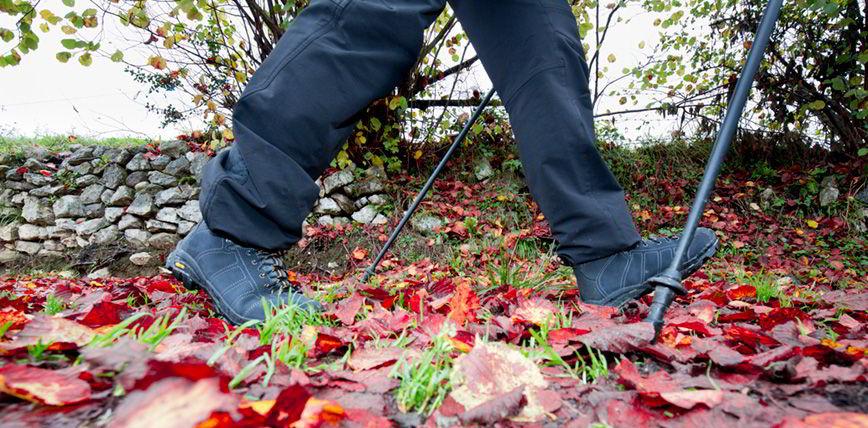
Pilgrim to Cuadonga/Covadonga
Thus, for example, in 1759, the Oviedo captain Cipriano González Santirso walked from Oviedo/Uviéu to Cuadonga/Covadonga in place of his elderly father to fulfil a promise made to the Virgin if she cured Cipriano himself of a childhood illness. On his way, he travelled along the central-eastern fringe of the interior of the region until he reached the slopes of Auseva to pray before the Santina.
On the other hand, there are numerous written and photographic testimonies of people who, over the centuries, came to this place to visit the Sanctuary and the Lakes, to the point of making the "Excursion to Cuadonga/Covadonga" an essential custom for Asturians, Indianos and visitors.
Whether on foot, or later on the train that reached the area on the Repelao or by bus or car, Cuadonga/Covadonga and its natural surroundings have been - and are today - the destination of a multitude of visitors who, moved by the Marian faith or by the desire to contemplate and connect with its beautiful natural environment, come from all corners of the country.
The result of this has been the consecration of several routes - today conveniently signposted as GR such as the classic route from Oviedo/Uviéu or its prologue in Mieres, which is the Pilgrim's Route; the Travesía Andarina which begins in Gijón/Xixón; the Camín del Oriente which crosses the Cuera from Llanes and enters the Picos de Europa, or the Ruta de la Reconquista, also known as the Camino Lebaniego, which makes the route a pilgrimage between Cuadonga/Covadonga and Santo Toribio de Liébana.
A feeling called Covadonga
Covadonga is a singular universe in the broadest sense of the term. A world of curious stories and boundless emotions that touch the visitor's heart, and many of these stories have the Virgin as their protagonist. A visit to Covadonga offers the traveller endless possibilities for an unprecedented vital immersion in a unique place, which is beyond geography and maps, and which often becomes a noble and deep-rooted sentiment.
The Santina, a universal devotion
/documents/39908/68682/2291048.jpg/d18eabaa-7c50-2476-16af-e64e43c04849?t=1679298427228

Novena to Covadonga
Since time immemorial, the Virgin of Covadonga has aroused a passionate and passionate devotion that has diverse expressions such as the promises - very visible in the famous Stairway of Promises that goes up to the Holy Cave -, or the Novena - a period of nine days of liturgy, prayers and procession that culminates every year on September 8th, Feast of the Virgin of Covadonga and Day of Asturias -, and which brings together thousands of faithful and visitors.
Precisely because of the devout passion that the Santina arouses, it is common to find images of her all over Asturias in churches, chapels, as well as in other civic spaces and even in homes. And beyond Asturias, the Virgin of Covadonga has always been a key symbol of Asturian identity.
This identity emotion called Covadonga has been strongly felt in all the Asturian communities outside the Principality, and in a very visible way in the Asturian Centres all over the world: in Spain, in other European countries, in America, Asia, Australia, etc.
In short, Covadonga is a symbolic and spiritual expression of Asturianness.
More than fifty cloaks
/documents/39908/68682/2291015.jpg/d510d949-c6d7-1198-6a9e-5c5a809f0300?t=1679298456176

The Virgin of Covadonga and her mantles
The Santina, "small and gallant" as she is popularly and affectionately called, is dressed in a mantle, and this is how she is usually seen by pilgrims and visitors. The Virgin of Covadonga has more than fifty cloaks, donated by different personalities and institutions over the centuries - the oldest one preserved intact is the one donated by Isabella II -. Frequently changed, they offer the pilgrim an image of the Virgin and Child in a great variety of colours and styles.
On her head, a golden crown with pearls on its edges and diamonds encrusted with a dove representing the Holy Spirit, the work of the Lenga priest and goldsmith Félix Granda Buylla. And above the Child another small crown, this one imperial, with crosses and fleur-de-lis in precious stones. These are the wreaths offered by the Asturian devotees in 1918. And the image is completed by the golden rose in his hand, an offering from the Teresian Association, which replaces the palm or baton of command that he may have held previously, judging by the prints preserved.
Two traditions. The well and the seven Spouts
/documents/39908/68682/2291160.jpg/a0ff68d6-c162-cfbf-cc4b-2d856f547e34?t=1679298416847

Fuente de los siete caños y el pozón (Fountain of the seven spouts and the well)
The silence that reigns in the grotto is interrupted by the natural spectacle that unfolds beneath it: the waterfall or "chorrón" of the river Mestas that emerges from the rock and flows sonorously into the pond popularly known as "el pozón", whose channelling is the only thing that was carried out in Ventura Rodríguez's project. It is common for pilgrims and visitors to make an offering in the form of coins to the Santina, throwing them into the well.
Below the cave, on the left-hand side of this pool, is the Fountain of the Seven Spouts or Fountain of the Marriage, since, as Asturian tradition records, "The Virgin of Covadonga has a very clear fountain. The girl who drinks from it gets married within the year".
The unique story of the Campanona
/documents/39908/68682/2290680.jpg/cadcdcfb-8349-680f-0a0c-ea3426579534?t=1679298445858

La campanona
Covadonga is a place of prodigious stories, and one of these stories is that of the campanona, which is located in the vicinity of the Santa Cueva, in an elevated and peaceful spot, with splendid views over the esplanade of the Basilica.
The bell, as it is popularly known, is three metres high and weighs five thousand kilos, and has a romantic history: it was cast in La Felguera (Langreo) at the end of the 19th century by the Compañía Asturiana de Metalúrgica, owned by the Austrian engineer Arnaldo de Sizzo, Count of Sizzo-Noris. It was taken to the Universal Exhibition in Paris in 1900, where it was awarded first prize in its category. And over the years - back in the 1950s - the bell was donated to the Sanctuary of Covadonga.
The bell is a true work of art. The bas-reliefs sculpted by the Italian Francesco Saverio Sortini on the iron are simply spectacular, surprising, a whole universe of classical stories, both Christian and pagan.
The Royal Site of Covadonga experienced one of its most populous years ever in the Jubilee year of 2018.
2018 was an exceptional year in the history and daily life of the Royal Site of Covadonga. On the occasion of the Centenary of the Coronation of the Virgin of Covadonga and the Child Jesus, and the celebration of the Marian Jubilee Year, Cuadonga/Covadonga maintained an intense and incessant pastoral activity, which allowed thousands and thousands of pilgrims to come to this very special place.

